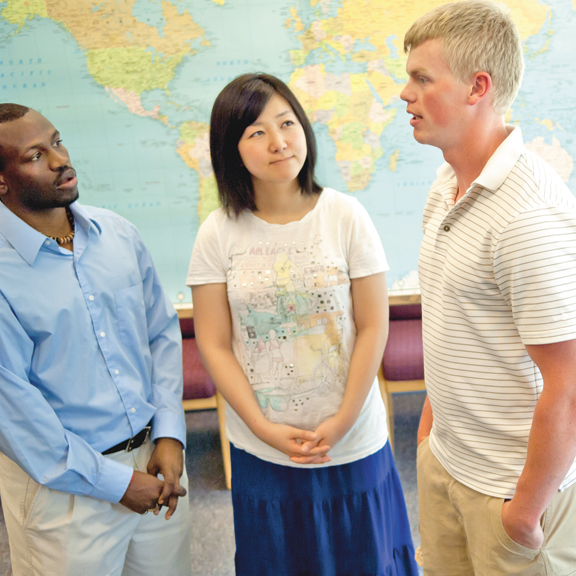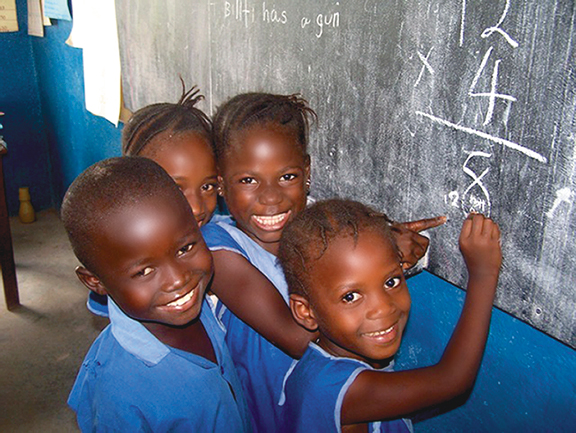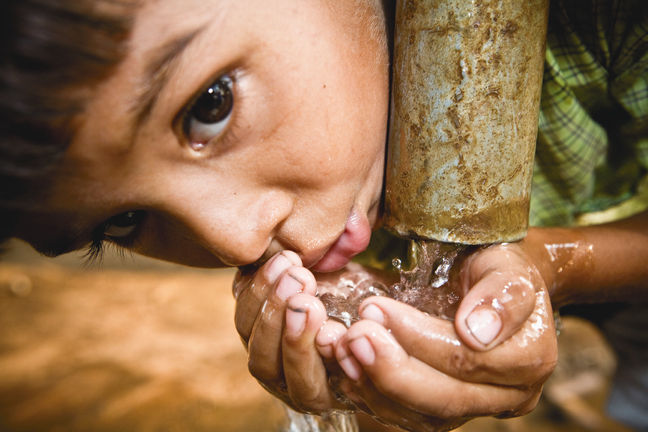 Like other institutions of higher learning, Minnesota State Mankato draws people seeking personal and professional growth. But there is more than personal fulfillment going on here.
Like other institutions of higher learning, Minnesota State Mankato draws people seeking personal and professional growth. But there is more than personal fulfillment going on here.
Many people on campus—faculty, staff and students—make time to serve others locally and around the world, which has resulted in a growing culture of community service on campus.
While there is no central clearinghouse of community service data at the University, the Office of Community Engagement estimates that the number of hours donated by faculty, staff and students each year extends into the tens of thousands. All of the academic colleges offer at least one course with a service-learning component, and the University works with more than a hundred agencies locally in some capacity.
Students, faculty and staff play pivotal roles in helping others in need. And, along the way, they build global connections that tie Minnesota State Mankato to the rest of the world as well.
When the Earth Moved
On March 11, 2011, an 8.9-magnitude earthquake, along with its aftershocks and ensuing tsunamis, devastated Japan. The earthquake toppled buildings and destroyed roads. Thirty-foot walls of water washed over rice fields, engulfed entire towns and dragged houses onto highways. Thousands of people were killed or displaced.
The world was struck by the tragic reports and the devastating images being shown on television and the Internet. The news was especially alarming for student members of Minnesota State Mankato’s Japanese Intercultural Association, many of whom have family and friends living in Japan. “We first heard the news of the earthquake by chance,” says Satomi Sugiyama, the current president of the Japanese Intercultural Association. Her friend happened to be checking for general news about Japan when reports of the earthquake started pouring in. “My friend’s family was in the area hit, and she was very anxious,” Sugiyama says. Fortunately, all immediate family members were accounted for within a day or two.
Still, Japanese students attending Minnesota State Mankato felt compelled to help—but they were unsure about what kind of success they would have raising money on campus. “It is uncomfortable in our culture to ask for donations,” explains Sugiyama. But the group set aside their own personal discomfort to help others. “The need was great,” she says, “and we wanted to do something.”
Although the JIA didn’t have a very formalized organization, they had origami paper and knew how to make paper cranes. It didn’t take long for the students to develop a plan of action. The earthquake struck on a Friday. By noon the following Monday, the students had a table set up in Centennial Student Union to hand out origami cranes and collect donations. They went to the International Festival in April as well, soliciting more donations from community members who visited their table. To their surprise, people gave generously. “In three months,” Sugiyama says, “we raised nearly $11,000 for relief efforts in Japan.”
The group distributed those donations through the American Red Cross and directly to three of Japan’s most severely impacted areas. Now they are distributing their thanks across campus as well. “We are so grateful for the kind words and generous donations given by students, faculty, staff and community members,” Sugiyama says.
The Gift of Education
 Sheka Mansaray, a creative writing student at Minnesota State Mankato, has also seen the generous spirit of the Mankato community. He has just begun to scratch the surface of it in his efforts to improve educational opportunities for children in Sierra Leone, where he was born.
Sheka Mansaray, a creative writing student at Minnesota State Mankato, has also seen the generous spirit of the Mankato community. He has just begun to scratch the surface of it in his efforts to improve educational opportunities for children in Sierra Leone, where he was born.
Mansaray knows firsthand that education is the key to successful independence. Education, he says, changed his life. Now he would like to help change the lives of other boys and girls in Sierra Leone, where many children cannot afford even the most basic education.
After living in the United States for 12 years, Mansaray returned to Sierra Leone in December to visit his mother. Together, they toured his former elementary school and community. When he learned that many students are unable to go to school because they don’t have the $50 required by the government for tuition, he felt moved to do something about it.
“As a young child living in Sierra Leone, we did not have a lot—but we did have enough to go to school,” says Mansaray. “I visited three villages and it was the same story. My mother said, ‘This is life here. If you don’t have the money, you don’t go to school.’”
Mansaray immediately contacted friends in the United States and was able to raise enough money to cover scholarships for five children on the spot. But he knew that was not enough. When he returned to Mankato, he organized a fundraiser on campus and, with his friend Sam Bangura, a psychology major, established 50 Strong, 50 Wise (50strong50wise.com). The goal of the charitable organization is to raise enough money to send at least 50 students in Sierra Leone to school.
Mansaray and Bangura each moved to Minnesota as young children to escape the difficulties of living in the middle of a war zone. They met in Cottage Grove on Bangura’s first day of school; Mansaray was assigned to be his guide. Both feel fortunate to have been able to begin their studies at Minnesota State Mankato through the College Access Program. They know that many people in the United States take education for granted—but they understand how dramatically it can change a life.
Passionate about their mission to improve the lives of children in Sierra Leone through education, Mansaray and Bangura are connecting with community groups to solicit donations. They need backpacks, school supplies and, most importantly, money for tuition, uniforms and eventually even building materials for a new school. Mansaray’s dream is to be able to get enough land for the school so that he can build a soccer field, too. So far, the government has been willing to work with him. “I have cooperation from the government in Sierra Leone. They have agreed to give us the land for a school, so we just need to build the building,” Mansaray reports. “I feel really good about the project. People here understand the need.
Skillful Solutions
Minnesota State Mankato’s student chapter of Engineers Without Borders was just incorporated in spring 2010. But before the end of that year, it had already made a global impact. In December, eight students and a professional mentor traveled to El Salvador to help bring potable water to a small village and a regional public school. Members of the EWB chapter visited the village of Piedras Azules for a 10-day assessment trip. The group took detailed design notes and pictures of the area water service and collected water samples. Derek Olinger, Minnesota State Mankato’s student EWB chapter president, said the experience impacted him in ways he did not expect. “It changes your perspective on lots of things,” he says.
 The village, Olinger explains, doesn’t receive reliable water service during the dry season, which requires villagers to embark on a daily, two-mile walk to retrieve water. “When you are there, you see firsthand the way people live. Here, we turn on the faucet and there is water 12 months a year, 24 hours a day,” Olinger says. “It’s hard to be successful in school or work if you need to spend so much time tending to basic living needs like hauling water.”
The village, Olinger explains, doesn’t receive reliable water service during the dry season, which requires villagers to embark on a daily, two-mile walk to retrieve water. “When you are there, you see firsthand the way people live. Here, we turn on the faucet and there is water 12 months a year, 24 hours a day,” Olinger says. “It’s hard to be successful in school or work if you need to spend so much time tending to basic living needs like hauling water.”
The Mankato student chapter of EWB has also had an impact closer to home. In its first few months of existence, members used scrap materials from construction projects to build two huts that were donated to Feed My Starving Children, which uses them as educational tools, showing the common homes of people living in third-world countries.
Although the mission of EWB is to provide engineering solutions around the world, the students involved gain almost as much as they give. They have the opportunity to apply what they’ve learned in the classroom in a real-world setting. They work side-by-side with professionals to create solutions in the field. And they are able to develop an appreciation for various cultures—and personal connections with people half a world away as well.
A University with a Big Heart
The University recognizes and supports community service efforts to build global connections and global solutions. In fact, President Davenport charged the community in the first strategic action step of the 2010-2015 strategic vision to “Change the world by collaboratively addressing our planet’s most challenging problems. Reaching around the world to those in need is the most direct way to collaboratively provide solutions.”
Service to others is embraced and promoted across campus and beyond. Service grants, curriculum modifications, the inclusion of global citizenship as a cornerstone of the newly revamped Honors Program and an annual Distinguished Alumni Humanitarian Award offer a few highlights of the University’s commitment to global involvement.
Betty Wariari, the 2011 Distinguished Alumni Humanitarian Award winner, graduated from Minnesota State Mankato in 2008 with a master’s degree in community health. She credits much of her success to the mentorship she received in Mankato. “Minnesota State Mankato is a university with a big heart that bends to accommodate the vision and passion of its students,” Wariari says.
That is high praise from someone who has dedicated her career to improving global health.
Currently, Wariari works in Lesotho, South Africa, where the adult life expectancy is just 46 years. “With the goal of increasing the rate of prevention of mother to child transmission of HIV, I focus on addressing implementation gaps and increasing accessibility to life-saving services,” she explains.
From Mankato to Japan, Sierra Leone, Central America and Africa, Minnesota State Mankato students, alumni, faculty and staff demonstrate the art of global giving. The culture of giving back is strong here. And it shows.
Giving Examples
- In May 2011, 16 students and two faculty members from the College of Social & Behavioral Sciences traveled to South Africa to distribute more than 45 pairs of shoes, 45 pairs of socks and 20 T-shirts donated by Scheels to impoverished children as part of a service-learning project.
- In 2010, a group of Somali students at Minnesota State Mankato formed the Somerican Student Association and started meeting with area high schools to encourage other Somali students to attend college and to support them along the way as well. “This is how they are giving back to their community,” says Abdul Kadir Alasow, the group’s advisor.
- After Hurricane Katrina devastated the Gulf Coast in 2005, the University established a Katrina Relief Fund to provide financial help for Minnesota State Mankato students and others connected to the University who were impacted by the hurricane. The fund provided money for transportation to reunite families, scholarship support for education costs at Minnesota State Mankato, money for clothing, food, books, personal hygiene supplies and a number of other urgent needs.
Speak Your Mind